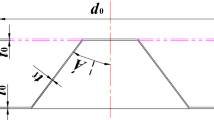Abstract
The non-axisymmetric cone has broad application prospects and is feasible to be manufactured via die-less shear spinning process which however lacks of research. With the roller path equation and other boundary conditions, the finite element model for non-axisymmetric die-less shear spinning process is established and simulated by adopting ABAQUS/explicit software in this study. The FEM results are experimentally verified by comparing the morphology and the HCAs. The distribution of stress and strain in different working conditions and the ellipticity and the elongation of the material in different spinning process during non-axisymmetric die-less shear spinning process are analyzed. It shows that the 0° area of the flange is the position where the wrinkle occurs easily, and the elongation of the material reaches the maximum value; the larger equivalent stress and strain distribute on the conical surface with the smaller HCA. With the movement of the roller, the ellipticity of the cross section increases in the bigger HCA working conditions, but decreases in the smaller HCA working conditions due to the combined effects of the deformation and the springback.
Similar content being viewed by others
References
Xia Q, Xiao G, Long H, Cheng X, Shen X (2014) A review of process advancement of novel metal spinning. Int J Mach Tools Manuf 85(7):100–121
Zhan M, Yang H, Guo J, Wang XX (2015) Review on hot spinning for difficult-to-deform lightweight metals. Trans Nonferrous Metals Soc China 25(6):1732–1743
Kwiatkowski L, Melsheimer O, Wenzel S, Kunert J, Tekkaya AE (2010) Experimental investigation of tool path strategies for incremental necking-in. Int J Mater Form 3(3):967–970
Zhao Y (2005) Present situation of spinning technology. Forging and stamping Technol 30(5):95–97 (in Chinese)
Zeng R, Ma F, Liang H, Jianjun L (2015) Investigation on spinnability of profiled power spinning of aluminum alloy. Int J Adv Manuf Technol 80(1):535–548
Jiang SY, Zheng YF, Ren ZY, Li CF (2009) Multi-pass spinning of thin-walled tubular part with longitudinal inner ribs. Trans Nonferrous Metals Soc China 19(1):215–221
Li Y, Wang J, Lu GD, Pan GL (2014) A numerical study of the effects of roller paths on dimensional precision in die-less spinning of sheet metal. J Zhejiang University Sci A 15(6):432–446
Gao XC, Kang DC, Meng XF, Wu HJ (1999) Experimental research on a new technology–ellipse spinning. J Mater Process Technol 94(2):197–200
Shimizu I (2010) Asymmetric forming of aluminum sheets by synchronous spinning. J Mater Process Technol 210(4):585–592
Xia QX, Lai ZY, Long H, Chen XQ (2013) A study of the spinning force of hollow parts with triangular cross sections. Int J Adv Manuf Technol 68(9–12):2461–2470
Lai ZY, Xia QX, Xu T, Cheng XQ (2011) Strain grid experiment of spinning of hollow part with triangular arc-type cross-section. J South China University of Technol 39(8):7–12 (in Chinese)
Sekiguchi A, Arai H (2012) Control of wall thickness distribution by oblique shear spinning methods. J Mater Process Technol 212(4):786–793
Han ZR, Fan ZJ, Xiao Y, Jia Z (2016) Research on thickness distribution of oblique cone in dieless shear spinning. doi:10.1007/s00170-016-9565-5Int J Adv Manuf Technol
Xia QX, Xie SW, Huo YL, Ruan F (2008) Numerical simulation and experimental research on the multi-pass neck-spinning of non-axisymmetric offset tube. J Mater Process Technol 206(1):500–508
Xia QX, Cheng XQ, Hu Y, Ruan F (2006) Finite element simulation and experimental investigation on the forming forces of 3D non-axisymmetrical tubes spinning. Int J Mech Sci 48(7):726–735
Xia Q (2004) Investigation on the mechanism of the spinning technology of the 3D non-axisymmetric parts. Chinese J Mech Eng 40(2):153–156 (in Chinese)
Cheng X, Feng W, Xia Q (2008) The study on the numerical simulation of non-axisymmetric tube neck-spinning and process parameters optimization. J plasticity engineering 15(4):61–66 (in Chinese)
Han Z, Xu Q, Jia Z, Li X (2015) Experimental research on oblique cone die-less shear spinning. Proceedings of the Institution of Mechanical Engineers Part B J Eng Manuf 78(23):11772–11782
Ding W, Zhang K, Yang C, Hu Z (2010) Study on the ovality of hollow shafts with equal inner diameter formed by CROSS wedge rolling. J Plasticity Eng 17(3):27–31 (in Chinese)
Author information
Authors and Affiliations
Corresponding author
Rights and permissions
About this article
Cite this article
Jia, Z., Han, Z.R., Liu, B.M. et al. Numerical simulation and experimental study on the non-axisymmetric die-less shear spinning. Int J Adv Manuf Technol 92, 497–504 (2017). https://doi.org/10.1007/s00170-017-0172-x
Received:
Accepted:
Published:
Issue Date:
DOI: https://doi.org/10.1007/s00170-017-0172-x



